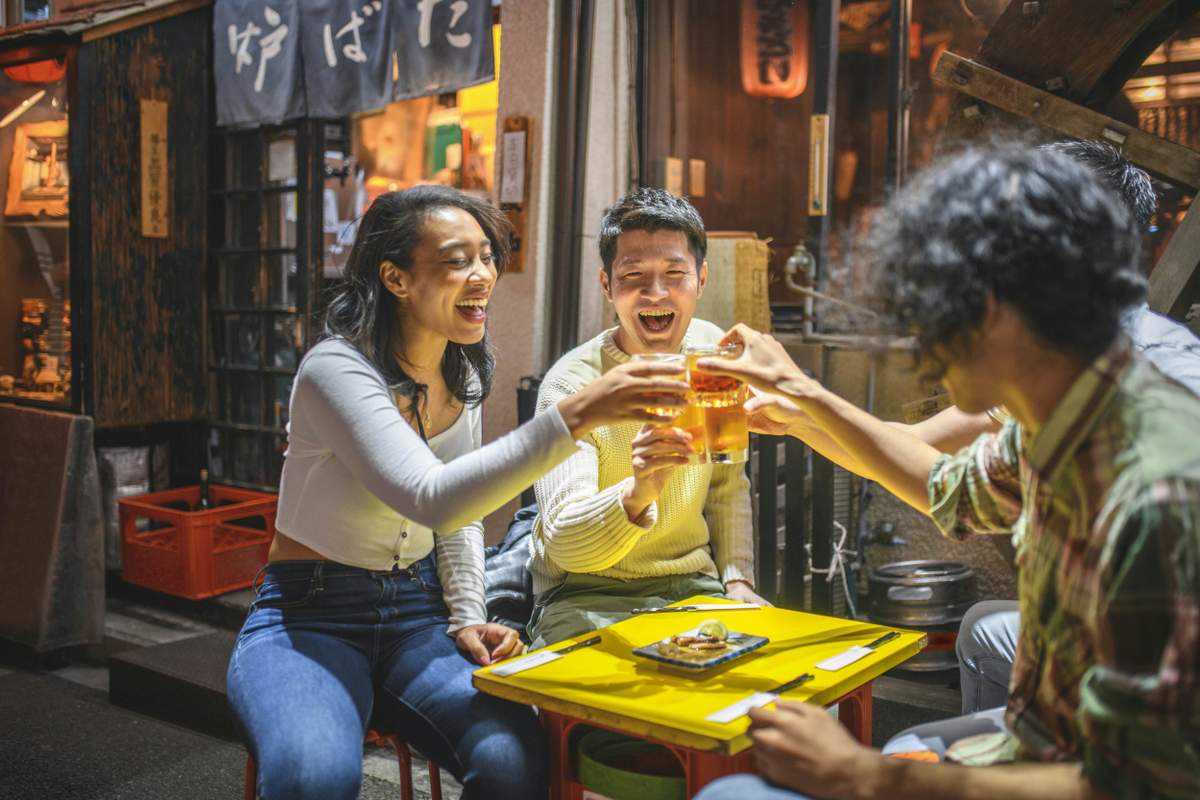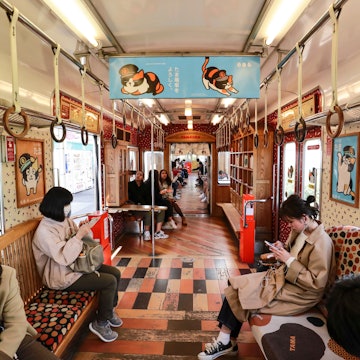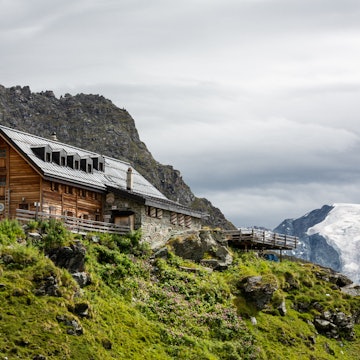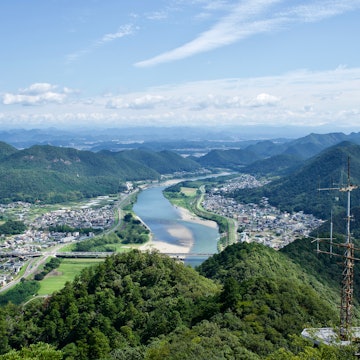
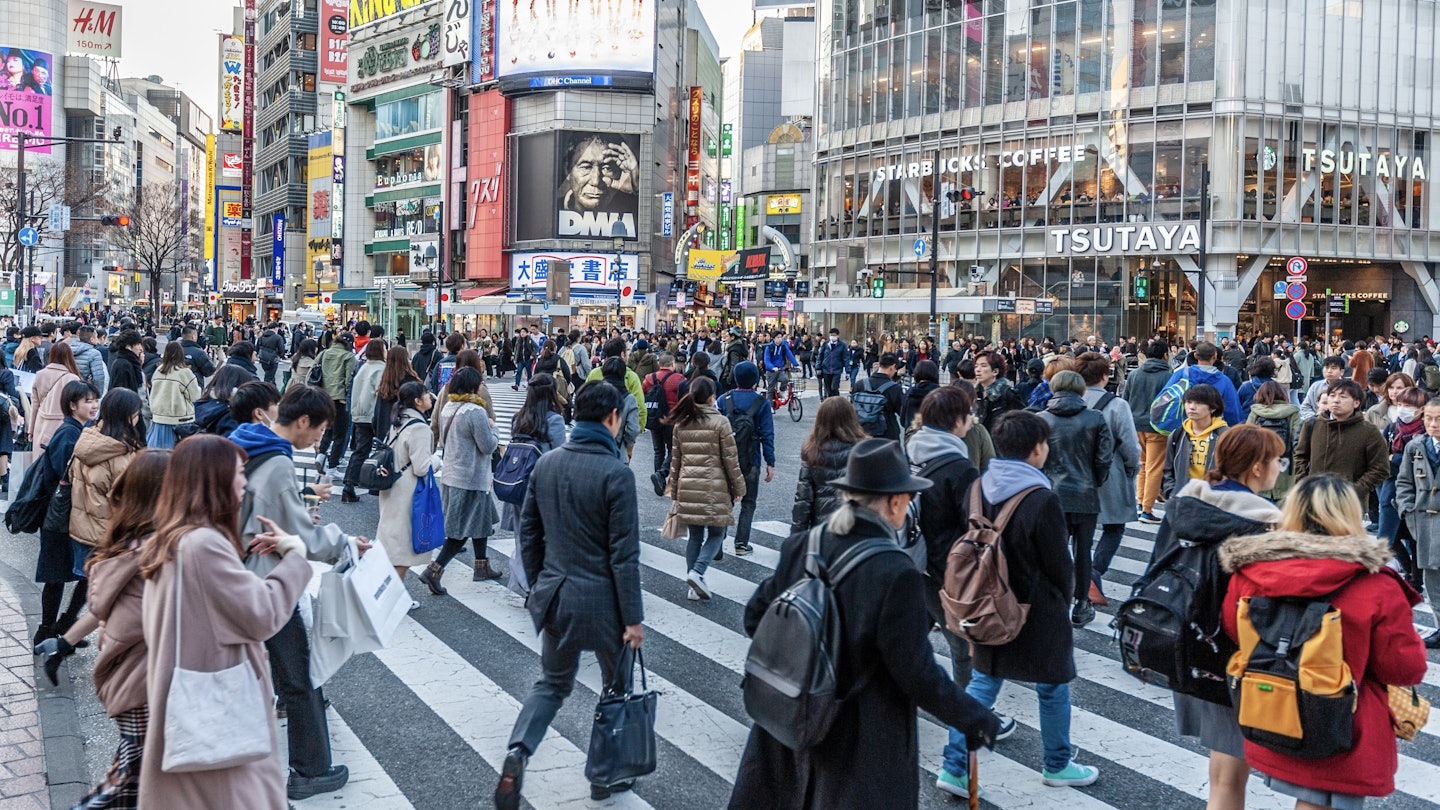
The crowds at the famous Shibuya Crossing. Goldilock Project/Shutterstock
With its youthful vibe and boundless energy, Shibuya is arguably the most vibrant part of Tokyo. The area has a justified reputation as a focal point for youth trends and fashion – but that’s far from all there is to this neighborhood.
Beyond the heaving streets around Shibuya Station, the wider Shibuya district is home to the sprawling grounds of Meiji-jingū (Meiji Shrine) and Yoyogi Park; sleek shopping centers and cool galleries; fabulous restaurants; and plenty of other attractions that merit a deep dive.
Here’s what first-time visitors to Shibuya need to know.

When should I go to Shibuya?
Anytime. Shibuya has something for all seasons and weather conditions: shops and galleries for a rainy day and green spaces like Yoyogi Park for when it’s warm and sunny. That said, like the rest of central Tokyo, be aware that things tend to get very hot and humid outside in the summer months. The famous crowds in Shibuya’s most popular spots tend to surge on weekends – though Shibuya has a habit of feeling busy no matter when.
How much time should I spend in Shibuya?
An afternoon and evening are more than enough to cover the area around Shibuya Station, where you’ll find the iconic Shibuya Crossing, the Hachikō Statue, and plenty of options for shopping and partying. If you want to explore other parts of the district, add a second day for a stroll along boutique-lined Omotesando, a look at the colorful fashions of Takeshita-dōri in Harajuku, and a visit to Meiji-jingū shrine.

Is it easy to get in and around Shibuya?
Yes, extremely. The second-busiest train station in the world (the first is nearby Shinjuku), Shibuya Station is served by several Japan Rail lines, including the Yamanote Line loop; three Tokyo Metro lines; and the private Keio and Tokyu railways. All this means it’s thoroughly connected to other parts of Shibuya, the rest of Tokyo and effectively all of Japan. You can also get straight to Shibuya from Haneda or Narita airports: the Narita Express has a service that stops at Shibuya; bus services also connect Shibuya and both airports. Once in Shibuya, it’s easy to get around the main areas on foot, although you’ll also find plenty of taxis.
Top things to do in Shibuya
Join the Shibuya Crossing throngs
The crossing by Shibuya Station’s Hachikō exit is a defining Tokyo sight. It’s said to be the world’s busiest crosswalk, with several thousand people converging from all directions every time the lights turn green. If you want to see the crossing without the throngs, head up to the open-air Shibuya Sky observation deck atop the 46-story Shibuya Scramble tower. At 751ft (229m) above ground, it also delivers sweeping views over the city…although it’s not for anyone skittish about heights.

Shop like a Shibuya teen
Every day, hordes of shoppers pour out of Shibuya Station, breaking like a wave across the Shibuya Crossing before spreading into an ocean of stores. Some will be headed for the Shibuya 109 building, where the 120 or so small boutiques have every youthful fashion trend covered. Others will be making a beeline for the pedestrian-only Center-gai street, where high-street fashions rub shoulders with colorful fast food joints. Connecting Shibuya and Harajuku is Cat Street, a proving ground for indie and street-fashion brands.
Chill in Yoyogi Park
Next door to Meiji-jingū, Yoyogi Park is Tokyo’s most famous green space – a place of vast lawns and lazy afternoons, where people from all walks of life come to unwind and hang out. In the people-watching department, you can expect all types, from cosplayers to dance crews to buskers and more. The park also hosts all sorts of festivals, from the annual Tokyo Pride in June – Japan’s biggest LGBTIQ+ celebration – to the popular Thai Festival in May.

Check out the art and design scenes
It shouldn’t be a surprise that an area known for its fashion trends should also have a vibrant art scene. In the swanky Hikarie complex by Shibuya Station, the eighth-floor Creative Space includes pop-up contemporary art shows at the Cube 1, 2, 3 gallery, as well as the functional, modern designs of everyday items at d47 Museum. In the backstreets of next-door Harajuku, a less polished option is the Design Festa gallery, which has long been a champion of up-and-coming local artists, with dozens of small gallery rooms that can be rented by the day.
Not that Shibuya is all about contemporary creations. The Toguri Museum of Art focuses on ceramics from the Edo era (1603–1868), while the Ōta Memorial Museum of Art, not far from Harajuku Crossing, houses a superb collection of woodblock prints that includes work by ukiyo-e legends Katsushika Hokusai and Utagawa Hiroshige.

My favorite thing to do in Shibuya
Being in my forties, I’m painfully aware that much of the Shibuya Station area hasn’t been geared to me for at least 20 years…and if I did start hanging out there, my teenage son would be mortified to bump into me. Meiji-jingū, however, is a place I’ll never grow too old for.
While it (justly) attracts lots of visitors, it still retains an air of calm and tranquility that feels deeply removed from nearby Harajuku and the youthful vibrancy of Takeshita-dōri. In the process, the complex opens a window on Japan’s spiritual side and rituals – when, for example, you purify your hands before entering the sacred main compound, or spot a traditional wedding procession. It’s also free – with the exception of the Inner Garden, which is well worth the small admission fee when the irises bloom in June.
How much money do I need for Shibuya?
Prices vary greatly in Shibuya. High-end sushi, for example, can easily cost you more than ¥15,000 (US$100) – while a good dinner at a conveyor-belt sushi chain, such as Kura Sushi or Uobei, could be just ¥2000–3000 (US$13–20). Thanks to the area’s youthful focus, there are plenty of deals around.
It’s always handy to carry cash in Tokyo, as some restaurants and smaller stores don’t take cards. Still, cashless and contactless payments are increasingly the norm. You can often pay with contactless transport cards (such as Pasmo and Suica), and with smartphone apps like PayPay, Rpay and LinePay. Stores typically display the logos of accepted payment methods at the checkout area.
Double room at a two- or three-star hotel: from ¥25,000 (US$165)
24-hour unlimited-ride Tokyo Metro pass: ¥700 (US$4.70)
Filtered coffee at an independent cafe: from ¥500 (US$3.30)
One plate of sushi at Kura Sushi: from ¥150 (US$1)
Admission to Shibuya Sky observation deck: ¥2200 (US$15)
Admission to Ota Memorial Museum of Art: from ¥1000 (US$6.60)
Admission to Design Festa: free
Keep the party inside
For years, Shibuya had been known for its popular Halloween and New Year’s street parties. Unfortunately, they got too raucous for the authorities: after several years of unsuccessfully asking people to tone down their street celebrations, local authorities officially banned Halloween in 2024. At the same time, a year-round ban on public drinking between 6pm and 5am also came into effect in central Shibuya.

What’s with that dog statue near Shibuya Crossing?
That’s Hachikō, an Akita Inu at the center of one of Japan’s most enduring tales of loyalty. Back in the 1920s, Hachikō would come to the station every day to meet his owner, a professor at Tokyo Imperial University, as he returned from work. Until, that is, the professor passed away.
For the following decade, Hachikō still came to the station in the hope of seeing his owner – and in his own lifetime the dog became something of a celebrity, his story of unwavering loyalty capturing the hearts of the Japanese public.






